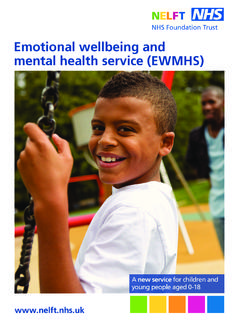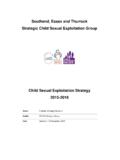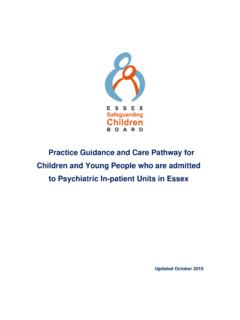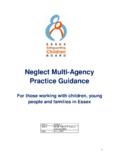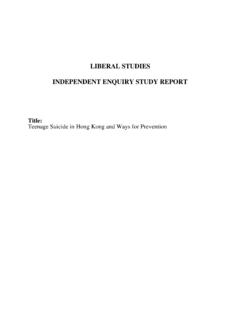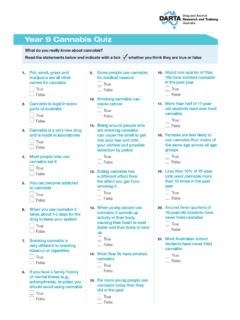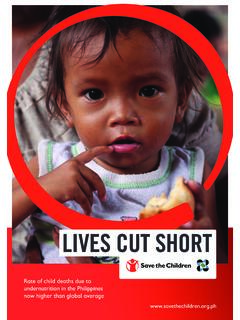Transcription of Teenage Suicide Prevention
1 Teenage Suicide Prevention What are basic human needs? Needs Achieving Self actualisation through the minefield of adolescence can be challenging to young people. Searching for their own identity whilst preparing to separate emotionally and physically from their families. Starting to feel responsible and a need to control themselves. Questioning things they did automatically Impact of hormones and sexual maturation. With a Teenage brain. We know that economic recession results in increased rates of Suicide , especially in men. The current economic climate involves a great deal of uncertainty. We do not know what the impact that Brexit will have over the next few years.
2 Youth unemployment Fewer local resources for young people. Academic pressures cost of further education.. Mental health, in effect refers to the capacity to live a full, productive life as well as the flexibility to deal with its ups and downs. In children and young people it is especially about the capacity to learn, enjoy friendships, to meet challenges, to develop talents and capabilities.. (YoungMinds,1996). 5. Achieving good emotional health. Children and young people need to feel safe and cared for in order to develop emotional well-being. Personal Resilience which can be used in the face of adversity is a key factor in enabling children and young people to manage emotional distress.
3 Whenever we are faced with any difficulty, the ability to survive the emotional and physical pain associated with the event will be influenced by our level of personal resilience Building Resilience Thinking without distortion is a major factor in understanding resilience: Positive view of the self & high self esteem. Robust, easy temperament & constitutional strength. Secure attachments & ability to trust. Social empathy & balance of leisure/ work life. Ability to take care of ourselves. Resilience Resilience is fostered and developed through relationships and connectedness with others. Grows through a gradual exposure to difficulties that the child young person learns to manage.
4 Children who have secure attachments and believe that the environment is a safe and supportive one are able to do this more effectively. Complex interplay between risk and resilience factors: As the number of risks accumulate for children or young people, more protective factors are needed to act as a counterbalance. Individuals are often able to cope, so long as the balance among risks, stressful life events and protective factors is manageable When risk factors and stressful life events outweigh the protective factors, even the most resilient individual can develop problems 9. The role of schools Schools can provide an emotionally healthy environments where children and young people can develop resilience.
5 An environment where there is an openness about managing emotions and children and young people who experience difficulties with this are not stigmatised. Where children and young people can be supported and encouraged to build relationships with other young people. Peer support and nurture groups can offer effective support. School Resilience Factors Positive everyday interactions between a teacher and a vulnerable pupil can develop a more positive view of relationships and build emotional resilience Significant Social Risk factors Social isolation, limited positive relationships Previous Suicide attempts (practice).
6 Sense of hopelessness, no future plans. Impulsivity. Presence of abuse or bullying Alcohol or substance misuse. A still developing ability to act in a reflective way, greater self-awareness in relation to others and increased self-consciousness place young people more at risk of impulsive and socially influenced suicidal thoughts and acts. Boys v Girls Nationally Teenage boys consistently don't present to CAMHS with the same volume as Teenage girls. Highest referral groups in Essex are typically adolescent girls and latency age boys. The recent statistics from NHS Digital (2016) show that 26 per cent of women aged between 16 and 24 reported symptoms of common mental health conditions a rise from 21 per cent when the study was last done, in 2007.
7 In 1993, young women were twice as likely as young men to exhibit common mental health symptoms, but they are now three times more likely to experience them. Young women were three times as likely as men to report such symptoms, with rates of 9 per cent among males of the same age, the figures show. (National Centre for Social Research, 2016). Teenage girls appear to be more at risk of mental health needs (but also are better at reporting needs). Higher prevalence of Suicide amongst young men however, but fewer are approaching services. Suicide rates are 3 times higher in Teenage boys than girls.
8 In Uk 15-19 years age group, tendency is about 4. per 100,000 for female and as many as 15 per 100,000. for males. Traditional thought in CAMHS suggests adolescent boys are more likely to manifest their emotional and psychological difficulties through challenging, isolating or anti-social behaviour. This in turn makes for more 'violent' acts and means of Suicide with higher 'success' rates. From 2013. data (mental health foundation) we also know that overall only 20% of those who commit Suicide are known to mental health services. In one UK study of 174 cases of Suicide in under 25. year olds: (148 males, 26 females) more individuals were of lower social class and unemployed than in the general population.
9 Nearly half ( ) of the young people had a history of previous self-harm, nearly half of these having carried out multiple episodes and 80% having self- harmed within the previous year. Little support was found for an earlier finding of increasing frequency of general practitioner visits shortly before death. Only of individuals were in the care of psychiatric services. (Houston, K., Hawton, K., Shepperd, R. (2001) Suicide in young people aged 15-24: a psychological autopsy study. Journal of Affective Disorders, 63, 159-170). The temptation is to jump to the conclusion that we therefore need to encourage more adolescent boys and in particular the remaining 80% to be accessing services more readily.
10 Is this the best approach however? Would this be trying to force a round peg into a square hole? Instead of forcing young people into an albeit evolving, but essentially pre-designed model of mental health, could we address the problem in a different way? We need to consider how all professionals build resilience in young people? Adults have greater activity in their frontal lobes than teenagers do. The frontal lobes of the brain are believed to affect: behavioural inhibition the ability to control emotions and impulses the place where decisions about right and wrong are made cause- effect relationships are processed The Teenage brain The Teenage brain Teenage brains are affected by the activity of the medial pre-frontal cortex; the area of the brain active in determining the significance of events to oneself.
